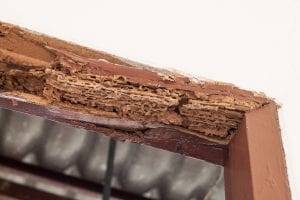
Termites are known as wood-eating insects that cause homeowners up to $5 billion in damage every year, according to the National Pest Management Association. But exactly what causes termites, where do they come from, and what do termites look like?
In this article, we’ll answer all of those questions so that you can identify a termite problem early on and call in the professionals for help right away to avoid substantial home damage.
What Causes Termites?
Different types of termites are attracted to homes for different reasons. For example, subterranean termites look for wood that is on the ground and that has moist soil nearby. Dampwood termites look for moist wood as well, but drywood termites prefer dry wood.
In general, termites love finding shelter in cracks in the exterior of buildings and in wood that is next to home foundations. Excess moisture around a home due to improper drainage or puddling around the foundation can also cause termites to become attracted to your home.
Where Do Termites Come From?
Some regions of the country are especially prone to termite infestations, and unfortunately, New Jersey is one of them. Termites live in nature but need constant sources of food, warmth, and moisture to survive. Wooden building materials are an ideal home for these insects, which is why they often enter basements, crawl spaces, and attics.
What Do Termites Look Like?
In terms of size, termites are about the size of ants; however, termites have straight waists and straight antennae. In contrast, ants have pinched waists and bent antennae.
Some termites can fly, and unlike ants, they leave their shed wings behind during the spring season. Many termites are about a ¼ inch long, which still makes them very difficult to identify and distinguish if you’re not a trained professional.
Where Do Termites Live
One of the most common types of termites, subterranean termites, live underground and build colonies of termites in the soil. These termites usually start their damage from the ground up and enter a home through the crawl spaces.
Meanwhile, drywood termites are problematic for homeowners because they like to take up residence in hardwood flooring and in wood furniture in homes. Drywood termites usually enter a home through the roof or attic and cause tiny holes in the wood structures near these areas.
Signs of Termites
Termites can be active all throughout the year, not just in the springtime, so it’s important to be on your guard about pests at all times. You may notice hollow-sounding wood in your home because termites like to eat out the inside of wood rather than eat the surface. You may also notice cracked paint on wood surfaces in your home. Other signs of termites include mud tubes on the outside of walls and discarded wings from the insects.
Once you notice signs of termites, don’t delay calling the New Jersey termite specialists, Precise Pest Control. We have over 25 years of experience in the industry and want to help you prevent unnecessary property damage in your home.





